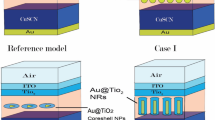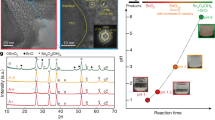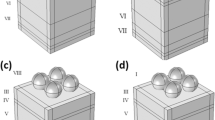Abstract
This study proposes a novel approach to improve the performance of third-generation solar cells, particularly perovskite solar cells (PSCs), by employing zinc oxide (ZnO) nanoparticles (NPs). The ZnO NPs are dispersed on the upper surface of the device, acting as nanodiffusers. This reduces reflection and increases solar radiation absorption in the photovoltaic active layer, enhancing the light pathway within the device. To analyze the impact of ZnO nanodiffusers on solar cell performance, computer simulations using the finite element method (FEM) and experimental analysis were conducted. Green synthesis methods were employed to synthesize ZnO nanoparticles with an average size of 160 nm, which were subsequently characterized. Thin films of ZnO NPs were deposited on the transparent indium tin oxide (ITO) electrode using spin coating, and their optical response was evaluated. This study proposes methodologies for optical and electrical modeling of third-generation photovoltaic cells using ZnO NPs. Optical computational modeling results evidence that ZnO nanospheres with a diameter of 160 nm predominantly scatter solar radiation in the forward direction. The incorporation of ZnO NPs (160 nm in diameter) reduces device reflectance, resulting in efficient light coupling and increased absorbance in the active layer. The integrated effects of light trapping and anti-reflective properties enhance photocurrent generation, leading to an increase in short-circuit current density. Experimental verification with ZnO NP deposition on PSCs confirms a 23.5% enhancement in photovoltaic device efficiency, increasing from 10.6 to 13.1% in an 11.68 cm2 perovskite cell. The study presents the optical benefits of ZnO nanostructures, including anti-reflective effects and light scattering, when integrated into devices containing thin films as active material.














Similar content being viewed by others
Data availability
The authors declare that they have availability of data and materials reported in this paper.
Code availability
The authors declare that they have availability of code reported in this paper.
References
NREL, Best Research Cell Efficiencies. https://www.nrel.gov/pv/assets/images/efficiency-chart.png Accessed 04 Jan 2024
S. Jung, Y. Lee, J. Youn, H. Moon, J. Jang, J. Kim, Effect of the active-layer thickness on the short circuit current analyzed using the generalized transfer matrix method. J. Inf. Disp. 14, 7–11 (2013)
C. Reynaud, R. Clerc, P. Lechêne, M. Hébert, A. Cazier, A. Arias, Evaluation of indoor photovoltaic power production under directional and diffuse lighting conditions. Sol. Energy Mater. Sol. Cells 200, 110010 (2019)
O. Cardozo, S. Farooq, A. Stingl, N. Fraidenraich, Investigation of performance of P3HT:PCBM organic photovoltaic module under real operating conditions. Sol. Energy 190, 543–548 (2019)
A.B. Nikolskaia, S.S. Kozlov, M.F. Vildanova, O.I. Shevaleevskiy, Power conversion efficiencies of perovskite and dye-sensitized solar cells under various solar radiation intensities. Semiconductors 53, 540–544 (2019)
M. Scharber, N. Sariciftci, Efficiency of bulk-heterojunction organic solar cells. Prog. Polym. Sci. 38(12), 1929–1940 (2013)
L. Stevens, O. Höhn, M. Hanser, N. Tucher, C. Müller, S. Glunz, B. Bläsi, Impact of the refractive index on coupling structures for silicon solar cells. J. Photon. Energy 11(2), 027001 (2021)
K. Li, S. Haque, A. Martins, E. Fortunato, R. Martins, M. Mendes, C. Schuster, Light trapping in solar cells: simple design rules to maximize absorption. Optica 7, 1377–1384 (2020)
Z. Pang, Y. Sun, Y. Gao, X. Zhang, Y. Sun, J. Yang, F. Wang, L. Yang, Unravelling the mechanism of interface passivation engineering for achieving high-efficient ZnO-based planar perovskite solar cells. J. Power Sources 438, 226957 (2019)
A.K.K. Kyaw, D.H. Wang, D. Wynands, J. Zhang, T.Q. Nguyen, G.C. Bazan, A.J. Heeger, Improved light harvesting and improved efficiency by insertion of an optical spacer (ZnO) in solution-processed small-molecule solar cells. Nano Lett. 13(8), 3796–3801 (2013)
C. Li, C. Han, Y. Zhang, Z. Zang, M. Wang, X. Tang, J. Du, Enhanced photoresponse of self-powered perovskite photodetector based on ZnO nanoparticles decorated CsPbBr\(_3\) films. Sol. Energy Mater. Sol. Cells 172, 341–346 (2017)
A. Stingl, M. Silva, V. Alves, C. Ayala, E. Rodrigues, Method of producing a metal or metal oxide nanoparticle (WO2021046586). (2021). https://worldwide.espacenet.com/patent/search/family/072355731/ publication/WO2021046586A1?q=phornano
Phornano, Verdequant, Zinc Oxide. https://www.phornano.com/verdequant Accessed 15 Dec 2023
E.S. Rodrigues, M.S. Silva, W.M. Azevedo, S. Feitosa, A. Stingl, P.M.A. Farias, ZnO nanoparticles with tunable bandgap obtained by modified Pechini method. Appl. Phys. A 125, 504 (2019)
O. Cardozo, S. Farooq, P.M. Farias, N. Fraidenraich, A. Stingl, R.E.D. Araujo, Zinc oxide nanodiffusers to enhance p3ht: pcbm organic solar cells performance. J. Mater. Sci. 33(6), 3225–3236 (2022)
C. Stelling, C.R. Singh, M. Karg, T.A.F. König, M. Thelakkat, M. Retsch, Plasmonic nanomeshes: their ambivalent role as transparent electrodes in organic solar cells. Sci. Rep. 7, 42530 (2017)
L.J. Phillips, A.M. Rashed, R.E. Treharne, J. Kay, P. Yates, I.Z. Mitrovic, A. Weerakkody, S. Hall, K. Durose, Dispersion relation data for methylammonium lead triiodide perovskite deposited on a (100) silicon wafer using a two-step vapour-phase reaction process. Data Brief 5, 926–928 (2015)
S. Farooq, C.V.P. Vital, L.A. Gómez-Malagón, R.E. Araujo, D. Rativa, Thermo-optical performance of iron-doped gold nanoshells-based nanofluid on direct absorption solar collectors. Sol. Energy 208, 1181–1188 (2020)
J. Cubas, S. Pindado, C. De Manuel, Explicit expressions for solar panel equivalent circuit parameters based on analytical formulation and the Lambert W-function. Energies 7(7), 4098–4115 (2014)
W. Tress, Organic Solar Cells Organic Solar Cells, Springer Series in Materials Science, vol. 208. (Springer, Cham, 2014), p.139
A. Khorsand Zak, R. Razali, W.H.B. Abd Majid, M. Darroudi, Synthesis and characterization of a narrow size distribution of zinc oxide nanoparticles. Int. J. Nanomed. 6, 1399–1403 (2011)
M. Farooqi, R. Srivastava, Enhanced UV–Vis photoconductivity and photoluminescence by doping of samarium in ZnO nanostructures synthesized by solid state reaction method. Optik 127, 3991–3998 (2016)
T. Baikie, Y. Fang, J.M. Kadro, M. Schreyer, F. Wei, S.G. Mhaisalkar, M. Graetzel, T.J. White, Synthesis and crystal chemistry of the hybrid perovskite (CH\(_3\)NH\(_3\)) PbI\(_3\) for solid-state sensitised solar cell applications. J. Mater. Chem. A 1(18), 5628–5641 (2013)
F.R. Lamastra, M.L. Grilli, G. Leahu, A. Belardini, R. Li Voti, C. Sibilia, D. Salvatori, I. Cacciotti, F. Nanni, Photoacoustic spectroscopy investigation of zinc oxide/diatom frustules hybrid powders. Int. J. Thermophys. 39, 110 (2018)
C. Guiot, O. Spalla, Stabilization of TiO\(_2\) nanoparticles in complex medium through a pH adjustment protocol. Environ. Sci. Technol. 47, 1057–1064 (2013)
Acknowledgements
The authors are grateful to Conselho Nacional de Desenvolvimento Científico e Tecnológico (CNPq), the National Institute of Science and Technology of Photonics (INCT de Fotônica), the Fundação de Amparo a Ciência e Tecnologia do Estado de Pernambuco (FACEPE) and the OeAD-GmbH. Austria’s Agency for Education and Internationalisation. Aykut Kıymaz acknowledge to Scientific and Technical Research Council of Turkey (TÜBITAK) for financial support of A. KIYMAZ in the frame of program 2219 with the Grant No.: 1059B192201447. Mrs. Deniz Kıymaz is acknowledged for valuable comments on the experimental section of this paper. Professors Niyazi Sariciftci and Markus Scharber are gratefully acknowledged for accepting Olavo Cardozo and Aykut Kiymaz as visiting scientists in the Linz institute for organic solar cells (LIOS).
Funding
The authors declare that this project was partially supported by CAPES (Coordenação de Aperfeiçoamento de Pessoal de Nível Superior).
Author information
Authors and Affiliations
Corresponding author
Ethics declarations
Conflict of interest
The authors declare that they have no known competing financial interests or personal relationships that could have appeared to influence the work reported in this paper.
Additional information
Publisher's Note
Springer Nature remains neutral with regard to jurisdictional claims in published maps and institutional affiliations.
Rights and permissions
Springer Nature or its licensor (e.g. a society or other partner) holds exclusive rights to this article under a publishing agreement with the author(s) or other rightsholder(s); author self-archiving of the accepted manuscript version of this article is solely governed by the terms of such publishing agreement and applicable law.
About this article
Cite this article
Cardozo, O., Farooq, S., Kıymaz, A. et al. Diffusion-enhanced efficiency of perovskite solar cells. J Mater Sci: Mater Electron 35, 876 (2024). https://doi.org/10.1007/s10854-024-12628-y
Received:
Accepted:
Published:
DOI: https://doi.org/10.1007/s10854-024-12628-y




